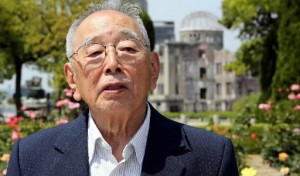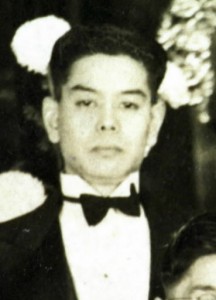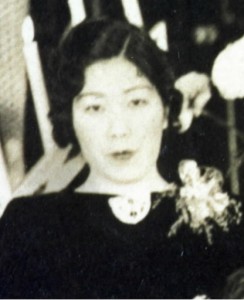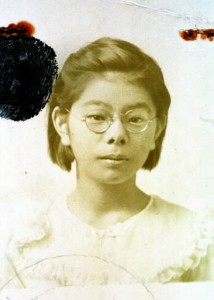Second-generation Japanese-American who survived A-bomb prays at Hiroshima Peace Memorial Park
May 27, 2016
by Masami Nishimoto, Senior Staff Writer
On August 6, 1945, Kazumi Sadamasa, 86, survived the atomic bombing and went in search of his family. His home had stood in the hypocenter area, the part of the devastated city that would eventually become the Hiroshima Peace Memorial Park. Unable to find even the remains of his parents and sister, Mr. Sadamasa left Japan and returned to the nation where he had been born, the United States, to start a new life. He says that he never wants another person in the world to suffer in the same way. On May 27, the second-generation Japanese-American and A-bomb survivor plans to follow President Barack Obama’s visit to Hiroshima, where Mr. Sadamasa again resides.
“I feel my parents and sister lying quietly here, even today,” he says. After returning to Japan three years ago, he began paying visits to the Peace Memorial Park and the hallowed ground of his former home, once located at 40-1 Nakajima Honmachi.
Grocery store in Hiroshima
Born in Seattle, Mr. Sadamasa moved to his parents’ homeland in 1938. His father returned to Japan first and opened a grocery store called “Fujiya” on the Nakajima Hondori shopping street, one of the liveliest parts of Hiroshima. After the family’s move to Japan, Mr. Sadamasa spoke with his sister and brother in English and continued his connections to the United States through newspapers sent from abroad and shortwave radio broadcasts. But in December 1941, Japan’s surprise attack on Pearl Harbor turned their lives upside down. In the spring of 1945, when the nation’s war effort was not going well, the Imperial Japanese Army’s Second General Headquarters was established in Hiroshima.
His sister, a student at Hiroshima Jogakuin Vocational School (today’s Hiroshima Jogakuin University), was mobilized to intercept shortwave radio communications because this assignment was given to female students who were Japanese-American. His elder brother, born three years before him, enrolled in the Naval Paymasters’ College after graduating from First Hiroshima Prefectural Junior High School (today’s Kokutaiji High School).
On August 6, his mother, Chiyoko, who was 39, was feeling poorly so his sister, then 20, prepared a lunchbox for Mr. Sadamasa, in his third year at First Hiroshima Prefectural Junior High School, to bring to his work site as a mobilized student. His father, Yoneo, then 45, advised him not to go that day. He never saw either one of his parents again.
He was listening to instructions about the work to a create a fire lane at the west end of Tsurumi Bridge when the atomic bomb exploded. He was about 1.5 kilometers southeast of the hypocenter and, after the blast, he found himself under a wagon, his neck and both hands badly burned. He hurried into the Kyobashi River to extinguish his smoldering clothes then left the water.
After receiving first aid in the Hijiyama district (part of today’s Minami Ward), on the opposite side of the river, he set out for the Nakajima district. People who had been scorched by the blast, and collapsed in flight, were pleading for water. Shinbashi Bridge, which spanned the Motoyasu River, had fallen in but a boat came down the river and Mr. Sadamasa begged the rower to take him across.
Describing the hypocenter, where the surface temperature had exceeded 3,000 degrees Celsius when the bomb exploded, he recalled: “There was no one in sight.”
Nearly choking from the heat, Mr. Sadamasa ran through the grounds of Seiganji Temple (located south of today’s Peace Memorial Museum) and went from the left bank of the Honkawa River to the Nakajima Hondori shopping street. He saw only a dying middle-aged woman and a man with his upper body submerged in the fire cistern in front of the spot where his house had stood. From Jisenji-no-hana, he crossed the Aioi Bridge and reached his relative’s home in the Koi district (part of today’s Nishi Ward), then collapsed.
Three years later, he reacquired his American citizenship and began working for a flower grower in California. His elder brother, Fumio (who died in 2013), worked hard as an interpreter for the British occupation forces that were stationed in Hiroshima.
A new life in the U.S.
Mr. Sadamasa was hit by fatigue in the United States, too. On each occasion, his parents would appear to him in a dream, saying, “Live your life,” and he mused alone on his parents’ words. He continued to forge a living as a seasonal farm worker and served in the army for three years, from 1954, when he was stationed in Saitama Prefecture. Talk of the atomic bomb was taboo at the time, but above all, he couldn’t bring himself to speak about it.
After leaving the army, he changed jobs from an American airline company to Japan Airlines, which was expanding its reach to North America. When he visited Japan on business, his brother encouraged him to start a family. Mr. Sadamasa took a wife, who was born in the city of Kure, and raised two sons and a daughter in the suburbs of San Francisco.
He said, “I’ve been hoping to live long enough to reach the age that totals the lives of my father and mother.” In straightforward words, he shared the impact of the atomic bombing on his life, including the lingering scar on his left hand, left by the bomb’s thermal rays. Mr. Sadamasa finally returned to live in Hiroshima because his wife, Toshiko, 81, wished to come back to Japan.
There are very few A-bomb survivors with a direct experience of the horrific conditions of the atomic bombing in the hypocenter area. Mr. Sadamasa also revealed his true feelings as to why he agreed to relate his A-bomb account for this article. “I hope no one will ever have to experience the horror and tragedy of a nuclear bombing,” he explained. “I sincerely hope we can create a world without war.”
(Originally published on May 27, 2016)
On August 6, 1945, Kazumi Sadamasa, 86, survived the atomic bombing and went in search of his family. His home had stood in the hypocenter area, the part of the devastated city that would eventually become the Hiroshima Peace Memorial Park. Unable to find even the remains of his parents and sister, Mr. Sadamasa left Japan and returned to the nation where he had been born, the United States, to start a new life. He says that he never wants another person in the world to suffer in the same way. On May 27, the second-generation Japanese-American and A-bomb survivor plans to follow President Barack Obama’s visit to Hiroshima, where Mr. Sadamasa again resides.
“I feel my parents and sister lying quietly here, even today,” he says. After returning to Japan three years ago, he began paying visits to the Peace Memorial Park and the hallowed ground of his former home, once located at 40-1 Nakajima Honmachi.
Grocery store in Hiroshima
Born in Seattle, Mr. Sadamasa moved to his parents’ homeland in 1938. His father returned to Japan first and opened a grocery store called “Fujiya” on the Nakajima Hondori shopping street, one of the liveliest parts of Hiroshima. After the family’s move to Japan, Mr. Sadamasa spoke with his sister and brother in English and continued his connections to the United States through newspapers sent from abroad and shortwave radio broadcasts. But in December 1941, Japan’s surprise attack on Pearl Harbor turned their lives upside down. In the spring of 1945, when the nation’s war effort was not going well, the Imperial Japanese Army’s Second General Headquarters was established in Hiroshima.
His sister, a student at Hiroshima Jogakuin Vocational School (today’s Hiroshima Jogakuin University), was mobilized to intercept shortwave radio communications because this assignment was given to female students who were Japanese-American. His elder brother, born three years before him, enrolled in the Naval Paymasters’ College after graduating from First Hiroshima Prefectural Junior High School (today’s Kokutaiji High School).
On August 6, his mother, Chiyoko, who was 39, was feeling poorly so his sister, then 20, prepared a lunchbox for Mr. Sadamasa, in his third year at First Hiroshima Prefectural Junior High School, to bring to his work site as a mobilized student. His father, Yoneo, then 45, advised him not to go that day. He never saw either one of his parents again.
He was listening to instructions about the work to a create a fire lane at the west end of Tsurumi Bridge when the atomic bomb exploded. He was about 1.5 kilometers southeast of the hypocenter and, after the blast, he found himself under a wagon, his neck and both hands badly burned. He hurried into the Kyobashi River to extinguish his smoldering clothes then left the water.
After receiving first aid in the Hijiyama district (part of today’s Minami Ward), on the opposite side of the river, he set out for the Nakajima district. People who had been scorched by the blast, and collapsed in flight, were pleading for water. Shinbashi Bridge, which spanned the Motoyasu River, had fallen in but a boat came down the river and Mr. Sadamasa begged the rower to take him across.
Describing the hypocenter, where the surface temperature had exceeded 3,000 degrees Celsius when the bomb exploded, he recalled: “There was no one in sight.”
Nearly choking from the heat, Mr. Sadamasa ran through the grounds of Seiganji Temple (located south of today’s Peace Memorial Museum) and went from the left bank of the Honkawa River to the Nakajima Hondori shopping street. He saw only a dying middle-aged woman and a man with his upper body submerged in the fire cistern in front of the spot where his house had stood. From Jisenji-no-hana, he crossed the Aioi Bridge and reached his relative’s home in the Koi district (part of today’s Nishi Ward), then collapsed.
Three years later, he reacquired his American citizenship and began working for a flower grower in California. His elder brother, Fumio (who died in 2013), worked hard as an interpreter for the British occupation forces that were stationed in Hiroshima.
A new life in the U.S.
Mr. Sadamasa was hit by fatigue in the United States, too. On each occasion, his parents would appear to him in a dream, saying, “Live your life,” and he mused alone on his parents’ words. He continued to forge a living as a seasonal farm worker and served in the army for three years, from 1954, when he was stationed in Saitama Prefecture. Talk of the atomic bomb was taboo at the time, but above all, he couldn’t bring himself to speak about it.
After leaving the army, he changed jobs from an American airline company to Japan Airlines, which was expanding its reach to North America. When he visited Japan on business, his brother encouraged him to start a family. Mr. Sadamasa took a wife, who was born in the city of Kure, and raised two sons and a daughter in the suburbs of San Francisco.
He said, “I’ve been hoping to live long enough to reach the age that totals the lives of my father and mother.” In straightforward words, he shared the impact of the atomic bombing on his life, including the lingering scar on his left hand, left by the bomb’s thermal rays. Mr. Sadamasa finally returned to live in Hiroshima because his wife, Toshiko, 81, wished to come back to Japan.
There are very few A-bomb survivors with a direct experience of the horrific conditions of the atomic bombing in the hypocenter area. Mr. Sadamasa also revealed his true feelings as to why he agreed to relate his A-bomb account for this article. “I hope no one will ever have to experience the horror and tragedy of a nuclear bombing,” he explained. “I sincerely hope we can create a world without war.”
(Originally published on May 27, 2016)











